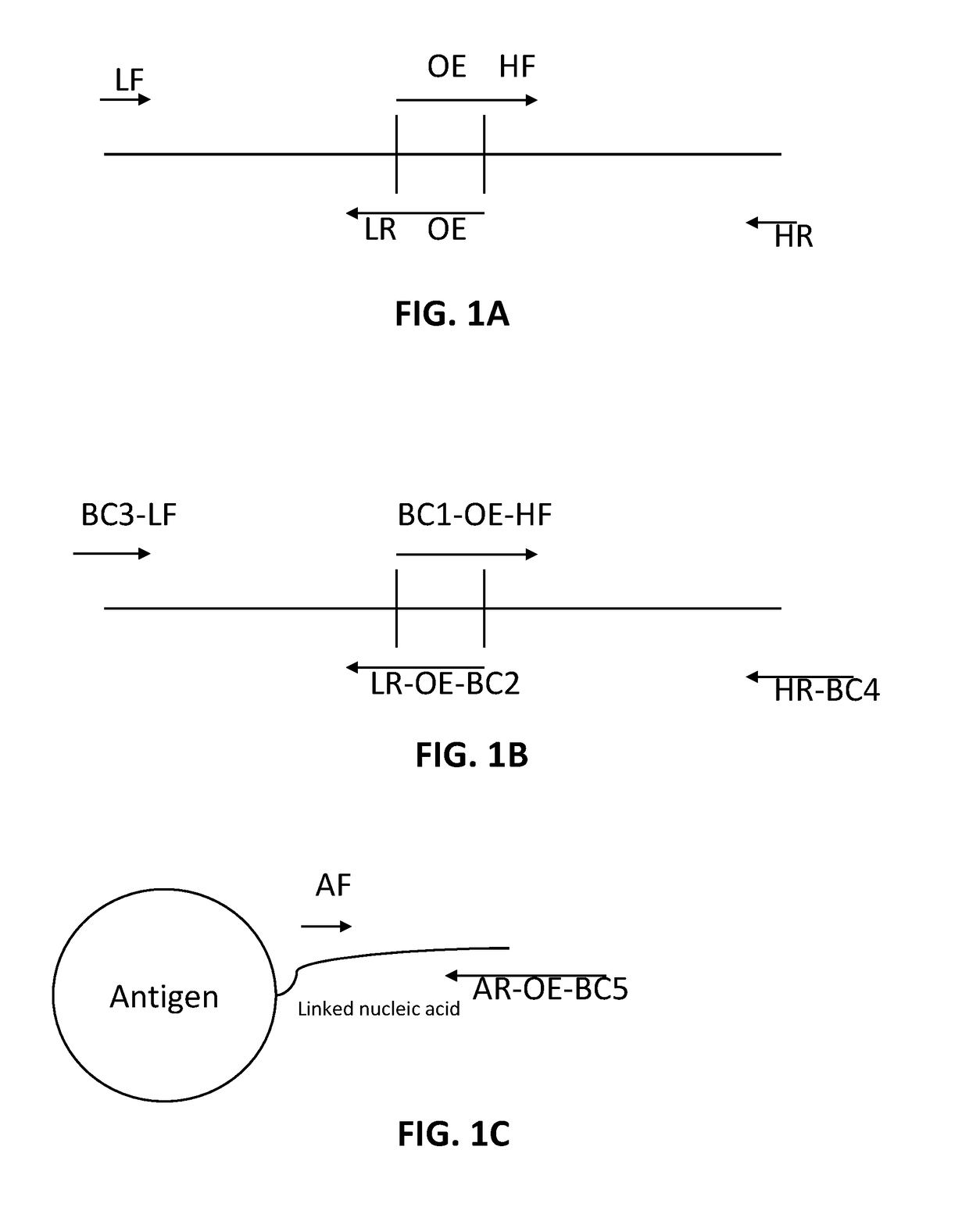Immune Repertoire Sequence Amplification Methods and Applications
a technology of immunogenes and sequences, applied in the field of immunogenes, can solve the problems of difficult identification of useful antibodies, limited application, and often considerable redesign of antibodies, and achieve the effects of limiting the useful antibodies obtained from the library, and reducing the number of antibodies
- Summary
- Abstract
- Description
- Claims
- Application Information
AI Technical Summary
Benefits of technology
Problems solved by technology
Method used
Image
Examples
example 1
Multiplexed Antigen Staining of Primary Cells
[0125]In some embodiments, barcoded peptide antigens are prepared by incubating antigens with an NHS DBCO heterobifunctional crosslinker. Secondly a DNA oligo with a 5′ primer site, a DNA barcode, a 3′ primer site, a 3′ poly dt, and containing a 3′ biotin and a 5′ azide are mixed with the peptide-DBCO antigens to make bar code labeled antigens.
[0126]In some embodiments, human B cells with membrane bound receptors are isolated using magnetic separation. Cells are incubated with the mixture of bar code labelled antigens so that labelled antigens bind membrane bound immunoglobulin receptors. The cells are washed and optionally the cells may be FACS sorted after incubating them with a streptavidin-PE fluorophore. In some embodiments, the cells are then single cell sorted into plates containing a Triton based lysis mixture and poly-dt primer with a 5′ amplification tag. In some embodiments, a reverse transcription reaction is performed with a ...
example 2
Multiplexed Antigen Library Sequencing Using Beads
[0127]A pool of B-cells bound to antigens is made as described in Example 1. In some embodiments, following antigen staining and washing, cells are separated with a monodisperse droplet generator. In some embodiments, the droplets comprise lysis / binding mix containing one or more barcoded poly-dt capture beads (beads coated with a DNA primer containing a 5′ amplification tag and a 3′ poly dT sequence) in a high salt / detergent buffer and 1-10 cells. In some embodiments, an oil phase is used to make an emulsion which oil phase is a perflurocarbon containing an amphiphilic fluorous / aqueous surfactant. As the cells lyse, their RNA is captured on the barcoded poly-dt beads as is the barcoded antigen DNA. In some embodiments, the emulsion is broken under stringent binding conditions, such as with methylene chloride and 6×SSC buffer. The bead mixture is washed twice and resuspended in a reverse transcriptase reaction and incubated. In some ...
example 3
Multiplexed Antigen Library Sequencing Using 5′5′ Primers
[0128]A 5′5′ primer is made by mixing a 5′ DBCO oligonucleotide and a 5′ azide oligonucleotide. In some embodiments, the DBCO and azide do not need to be at the precise 5′ end of the component oligos but may be placed in a manner that still allows for the 3′ end to perform a PCR reaction. The combined product is isolated from unreacted component oligos. In some embodiments, it may be higher yielding to use these 5′5′ primers instead of beads for linking reads to cell-specific barcodes. In some embodiments, a reaction uses primers containing a 5′5′ linkage with one of the 3′ ends containing a polyA and the other containing a 3′ light, 3′ heavy or 3′ antigen tag. In some embodiments, the reaction mix also contains 5′ heavy, 5′ light and 5′ antigen and 5′ amplification tag primers with 5′ phosphate groups. In some embodiments, an emulsion is generated with a monodisperse emulsion generator so that each droplet contains about 1 “t...
PUM
| Property | Measurement | Unit |
|---|---|---|
| molecular weight | aaaaa | aaaaa |
| bead size | aaaaa | aaaaa |
| bead size | aaaaa | aaaaa |
Abstract
Description
Claims
Application Information
 Login to View More
Login to View More - R&D
- Intellectual Property
- Life Sciences
- Materials
- Tech Scout
- Unparalleled Data Quality
- Higher Quality Content
- 60% Fewer Hallucinations
Browse by: Latest US Patents, China's latest patents, Technical Efficacy Thesaurus, Application Domain, Technology Topic, Popular Technical Reports.
© 2025 PatSnap. All rights reserved.Legal|Privacy policy|Modern Slavery Act Transparency Statement|Sitemap|About US| Contact US: help@patsnap.com

